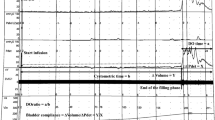Abstract
Objective: To evaluate the urologic safety of long-term Credé maneuver as bladder management in spinal cord injured patients.
Methods: Seventy-four paraplegics were included in this cross-sectional study. They were injured in the Tangshan earthquake in 1976. All patients have large volume (flaccid) bladders and have practiced the Credé maneuver for more than 20 years to expel urine. Current residual urine volume and urologic complications were investigated.
Results: 93.2% of patients have residual urine larger than 100 ml and 50% of cases larger than 300 ml. The prevalence of urologic complications is high: pyuria in 82.4%, urinary lithiasis in 31.3%, ureteral dilatation in 59.5%, hydronephrosis in 35.1% and renal damage in 16.2%. Men are more susceptible to upper urinary tract deterioration than women (P<0.05).
Conclusion: The Credé maneuver is not safe for long-term use in spinal cord injury patients, especially in men.
Similar content being viewed by others
Log in or create a free account to read this content
Gain free access to this article, as well as selected content from this journal and more on nature.com
or
Author information
Authors and Affiliations
Rights and permissions
About this article
Cite this article
Chang, SM., Hou, CL., Dong, DQ. et al. Urologic status of 74 spinal cord injury patients from the 1976 Tangshan earthquake, and managed for over 20 years using the Credé maneuver. Spinal Cord 38, 552–554 (2000). https://doi.org/10.1038/sj.sc.3101060
Published:
Issue date:
DOI: https://doi.org/10.1038/sj.sc.3101060
Keywords
This article is cited by
-
Current and future international patterns of care of neurogenic bladder after spinal cord injury
World Journal of Urology (2018)
-
Alarming blood pressure changes during routine bladder emptying in a woman with cervical spinal cord injury
Spinal Cord Series and Cases (2017)
-
Management of Neurogenic Lower Urinary Tract Dysfunction in Multiple Sclerosis Patients
Current Urology Reports (2015)


